
Dielectric and IR spectroscopy
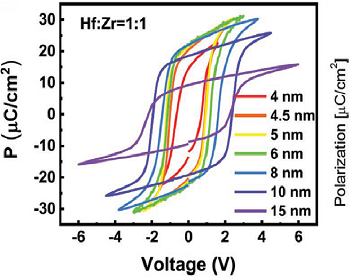
Application of HfO2 thin films in non-volatile memories – a review
We review main factors in preparation of HfO2 thin films and their physical properties which are important for applications in high-density resistive random access memories and ferroelectric memories [Small 18, 2107575 (2022)].
Ultrathin films of HfO2 become ferroelectric although bulk crystals are paraelectric. In this review we describe how grain size, thermal stress, dopants, oxygen vacancies, film thickness, annealing process and electrodes influence dielectric properties of HfO2, which are important for applications in high-density resistive random access memories and ferroelectric memories. We also discuss how to achieve superlative performance with high-speed reliable switching, excellent endurance and retention.
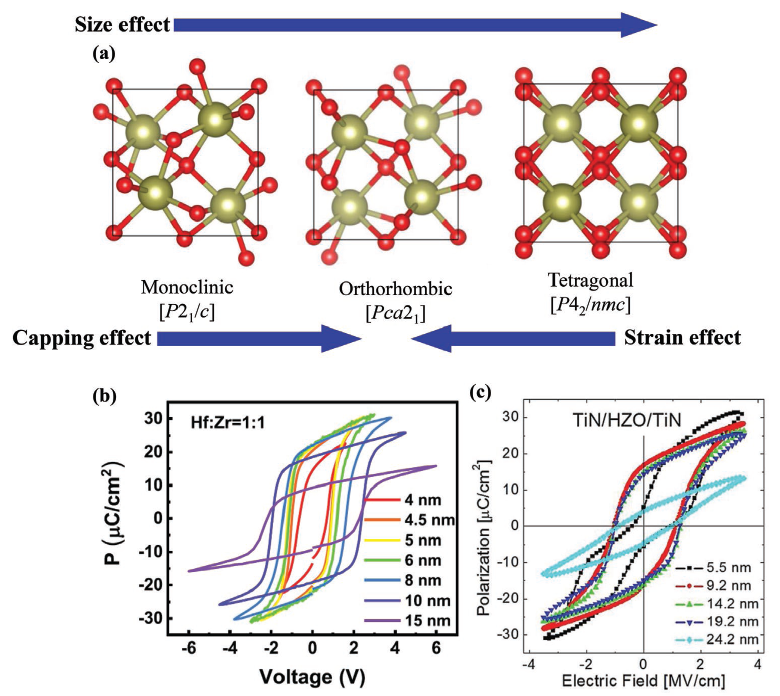
Figure: Dependence of crystal structure of HfO2 on the thin film thickness, strain and electrodes.
[1] W. Banerjee, A. Kashir, and S. Kamba, Hafnium Oxide (HfO2) – A Multifunctional Oxide: A Review on the Prospect and Challenges of Hafnium Oxide in Resistive Switching and Ferroelectric Memories, Small 18, 2107575 (2022).
(show less)
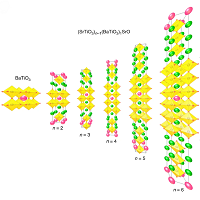
New material for 5G mobile networks
Epitaxial strained thin films of (SrTiO3)n-1(BaTiO3)1SrO were found to be a promising new material for mobile network of the 5th generation [Nature Mater. 19, 176 (2020)].
Epitaxial strained thin films of (SrTiO3)n-1(BaTiO3)1SrO were grown on DyScO3 substrates using molecular beam epitaxy [1]. The best microwave dielectric properties were discovered in samples with n= 6. Permittivity exhibits huge tuning using electric field and microwave dielectric loss is anomalously low. Unique properties were confirmed using first-principles calculations and by experimental observation of the soft mode behavior in THz region. These films are ideal for components in 5G networks.
Collaborating institutions: Prof. D.G. Schlom from the Cornell University and other American and German institutions.
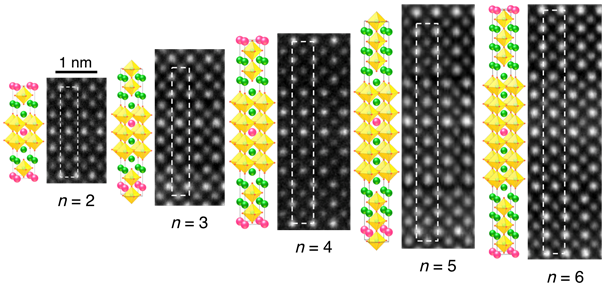
Figure: Schema of crystal structures of investigated (SrTiO3)n-1(BaTiO3)1SrO films and their view in scanning transmission electron microscope. Yellow octahedra depict TiO6 layers, green and red points mark atoms of Sr and Ba.
[1] N.M. Dawley, E.J.Marksz, A.M. Hagerstrom, G.H. Olsen, M.E. Holtz, V. Goian, C. Kadlec, J. Zhang, X. Lu, J.A. Drisko, R. Uecker, S. Ganschow, C.J. Long, J.C. Booth, S. Kamba, C.J. Fennie, D.A. Muller, N.D. Orloff, D.G. Schlomk, Targeted chemical pressure yields tuneable millimetre-wave dielectric, Nature Mater. 19, 176 (2020).
(show less)

Ferroelectric phase transition in water molecules localized in mineral cordierite
We discovered that hydrogen bonds are eliminated and the Coulombic interactions dominate in water molecules localized in nano-channels of mineral cordierite. Their dipole moment is perpendicular to the channel axis c and our dielectric spectroscopy study have revealed their ordering at ~3 K. The critical relaxation tending to this ordering is polarized along the a-axis direction and lies in the radiofrequency range. Spontaneous polarization measurements yield the saturated value of ~3 nC/cm2 at 0.3 K [Nat. Commun. 11, 3927 (2020)].
Water molecules localized in structural crystal nano-channels give a possibility to eliminate hydrogen bonds, dominating among water molecules at short distances up to ~2 Å which prevent ordering of their dipole moments. On larger distances 1-10 nm the Coulombic interactions dominate, which can lead to their ordering. We continued in our previous studies on beryl, where we, on cooling, have detected tendency to ferroelectric ordering, so called incipient ferroelectric behaviour. Mineral cordierite (Mg,Fe)2Al4Si5O18 also comprise structural channels similar to those in beryl, in which the chains of water molecules are ideally suited for the ordering study (Fig. 1).
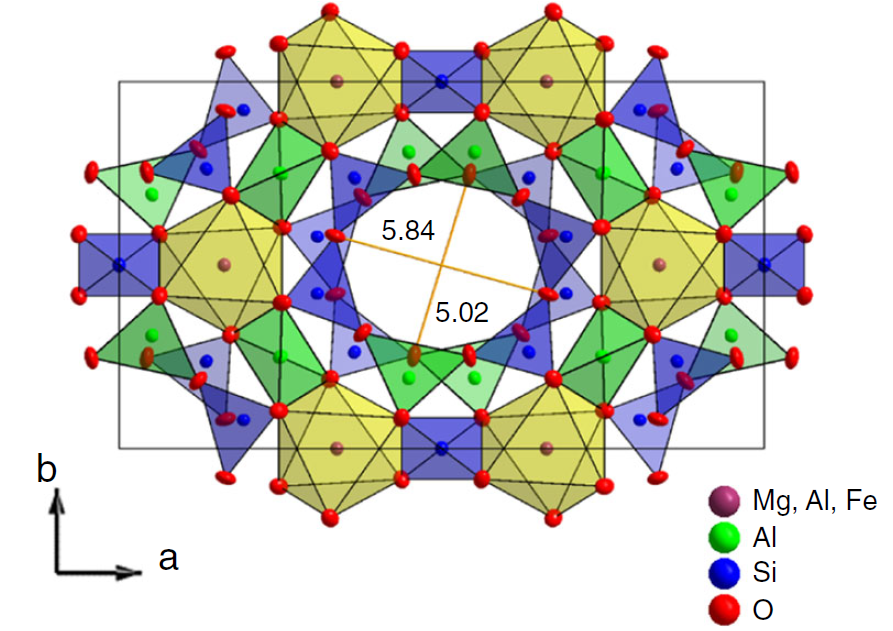
Figure 1: Cordierite crystal structure. Investigated water was localized in the free channels along the c-axis.
Crystal structure is orthorhombic, the channels in the c-axis direction are in the distance of 9.9 Å and the water molecules in the channels are by 4.7 Å from each other. Their dipole moment is perpendicular to the channel axis and our dielectric spectroscopy study have revealed their ordering at ~3 K. The critical relaxation tending to this ordering is polarized along the a-axis direction and lies in the radiofrequency range (Fig. 2). Spontaneous polarization measurements yield the saturated value of ~3 nC/cm2 at 0.3 K. Molecular dynamics calculations show the ferroelectric ordering in the plane perpendicular to the channels and antiferroelectric ordering along them.
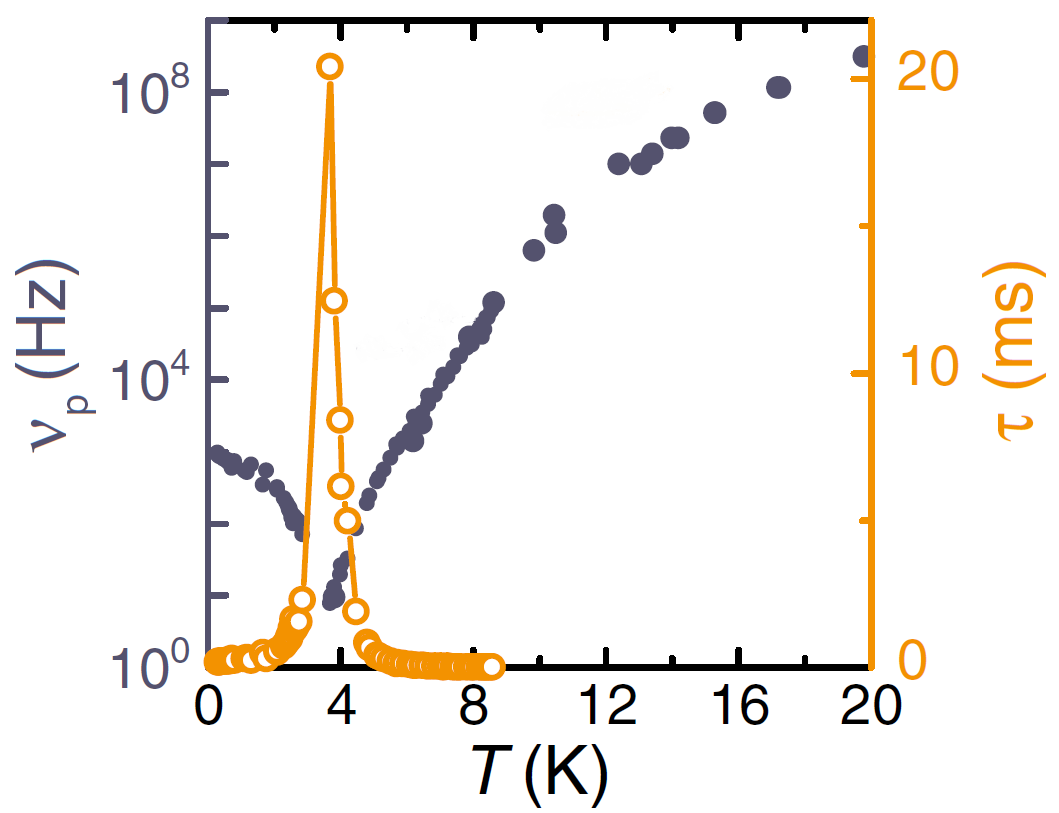
Figure 2: Ferroelectric phase transition of water in cordierite is induced by a critical slowing down of dielectric relaxation. νp denotes frequency of the maxima in the dielectric loss spectra and τ denotes the relaxation time of the relaxation.
[1] M. A. Belyanchikov, M. Savinov Z. V. Bedran, P. Bednyakov, P. Proschek, J. Prokleska, V. A. Abalmasov, J. Petzelt, E. S. Zhukova, V. G. Thomas, A. Dudka, A. Zhugayevych, A. S. Prokhorov, V. B. Anzin, R. K. Kremer, J. K. H. Fishcer, P. Lunkenheimer, A. Loidl, E. Uykur, M. Dressel, and B. Gorshunov Targeted chemical pressure yields tuneable millimetre-wave dielectric,
Nat. Commun. 11, 3927 (2020)
(show less)
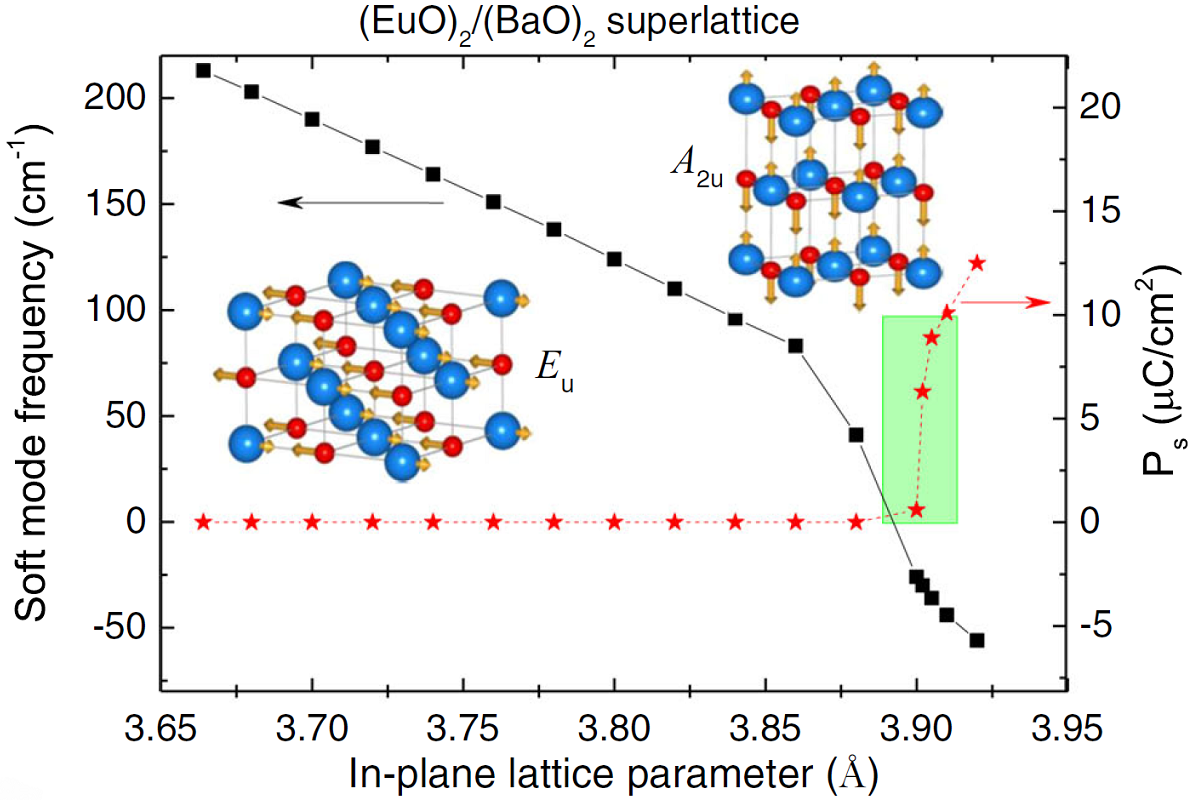
Making EuO multiferroic by epitaxial strain engineering
Optical soft mode driven ferroelectric phase transition was discovered in IR spectra of tensile strained ferromagnetic EuO thin films [Commun. Mater. 1, 74 (2020)].
The phase transition was predicted already ten years ago in films with 4% strain, but we have observed it only now in films with 6.4% strain. As such strain tends to relax after the epitaxial growth of only a few monolayers, we have achieved it in (EuO)2/(BaO)2 superlattices grown epitaxially on LSAT substrates. The observation is supported by a new DFT calculation.
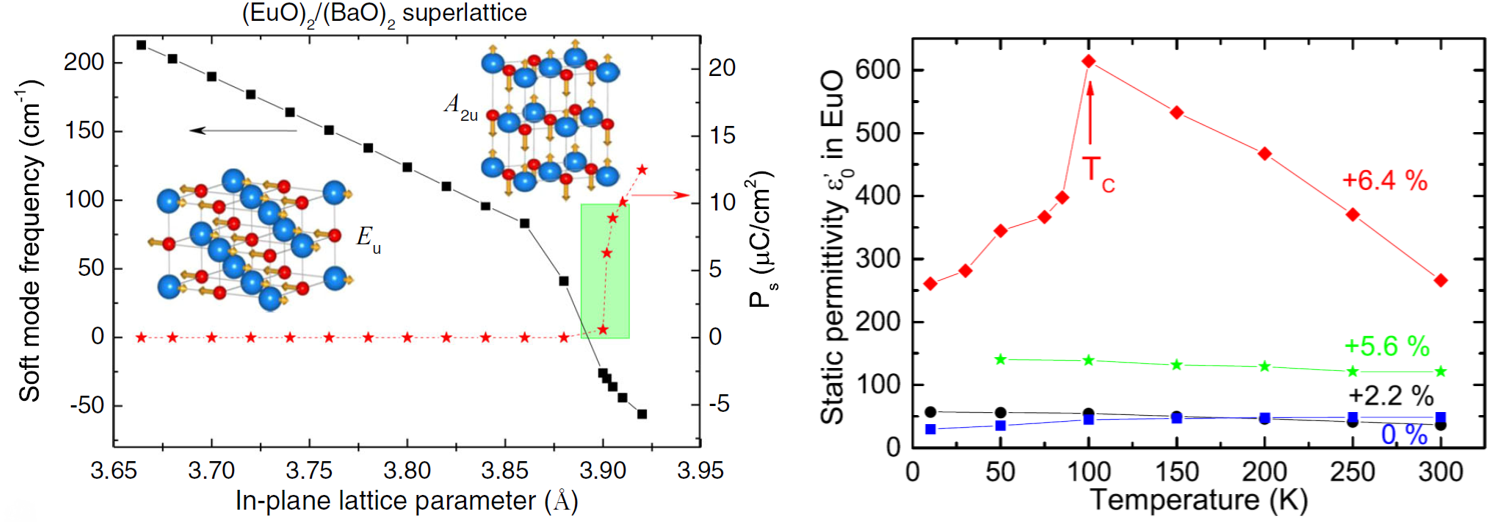
Figure:
Left: Theoretical strain dependence of the Eu ferroelectric soft mode frequency and
of the spontaneous polarization Ps in (EuO)2/(BaO)2
superlattice obtained from the DFT calculations. Insets show schematic eigenvectors of
the Eu and A2u symmetry polar phonons.
Rigth: Temperature dependence of the static permittivity of the EuO films and EuO layers
in the (EuO)x/(BaO)y superlattices with various tensile strain.
[1] V. Goian, R. Held, E. Bousquet, Y. Yuan, A. Melville, H. Zhou, V. Gopalan, P. Ghosez, N. A. Spaldin, D. G. Schlom, and S. Kamba, Making EuO multiferroic by epitaxial strain engineering, Commun. Mater. 1, 74 (2020).
(show less)
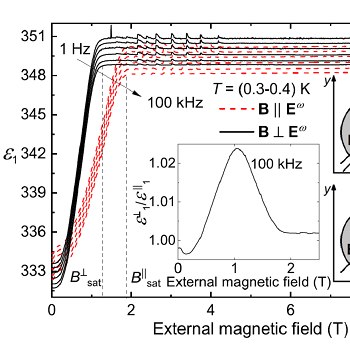
Seemingly anisotropic magnetodielectric effect in isotropic EuTiO3 ceramics
Anisotropic magnetodielectric effect was observed at 0.3 K in the low-frequency dielectric spectra of antiferromagnetic EuTiO3 ceramics [Phys. Rev. B 102, 144402 (2020)].
The effect was theoretically explained by a demagnetizing field and confirmed by magnetization measurements. THz refractive index revealed also a large anisotropy in external magnetic field. This anisotropy is due to activation of the ferromagnetic resonance only if the magnetic field is applied perpendicularly to the magnetic component of the THz radiation.
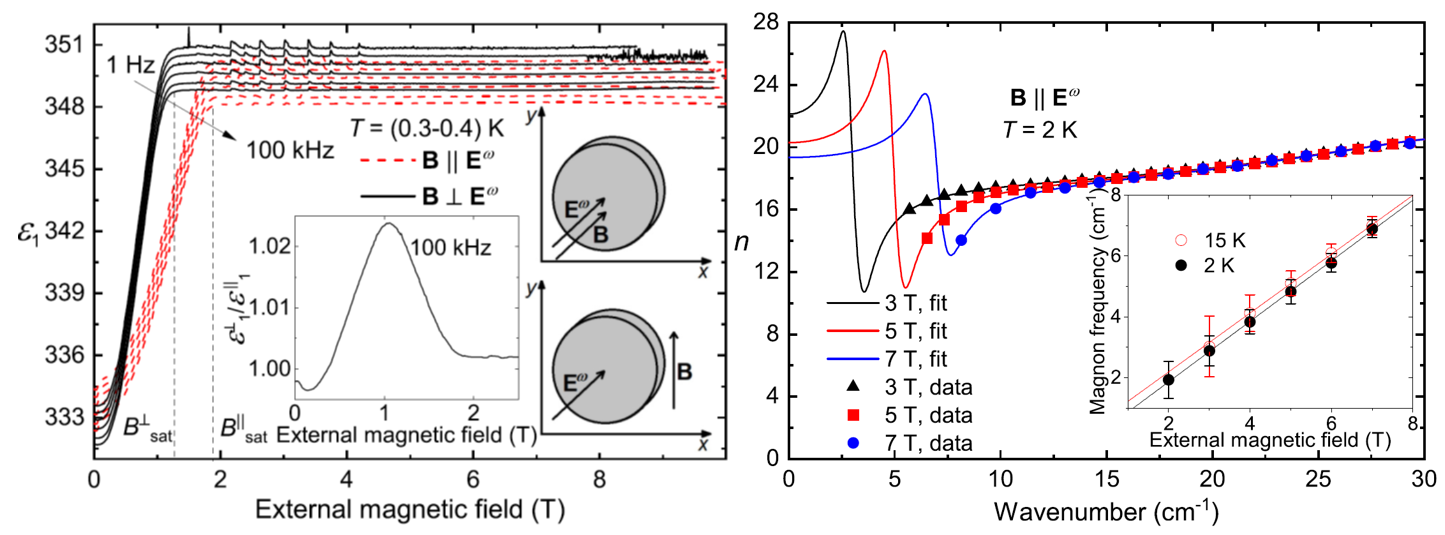
Figure:
Left: Magnetic field dependence of EuTiO3 permittivity measured for electric field applied perpendicularly to the sample plane, and with the static external magnetic field B in either of two orientations marked in the figure. Inset: Dependence of the permittivity ratio for two orientations of the magnetic field.
Rigth: THz refractive index measured at three magnetic fields applied perpendicularly to the electric vector of THz radiation. Inset: Magnetic field dependence of the magnon frequency measured at 2 and 15 K.
[1] D. Repček, C. Kadlec, F. Kadlec, M. Savinov, M. Kachlík, J. Drahokoupil, P. Proschek, J. Prokleška, K. Maca, and S. Kamba, Seemingly anisotropic magnetodielectric effect in isotropic EuTiO3 ceramics, Phys. Rev. B 102, 144402 (2020).
(show less)
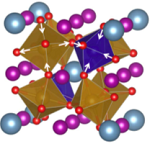
Changes in spin and lattice dynamics induced by magnetic and structural phase transitions in multiferroic SrMn7O12
Upon cooling, SrMn7O12 undergoes a series of structural and magnetic phase transitions from cubic to rhombohedral symmetry, and to an incommensurately modulated crystal structure, which is connected with charge and orbital ordering of the Mn cations. We report IR, THz, and Raman spectra of SrMn7O12 ceramics reflecting corresponding changes in the phonon selection rules, including new phonons appearing in spin-order-induced ferroelectric phases [1].
The observed phonon activities are compared with the predictions from the factor-group analysis. In the high-temperature phase, more phonons are observed than the number predicted for the cubic symmetry. This is explained by the presence of rhombohedral clusters in the cubic phase. The strongest variations occur in the THz spectra near the two magnetic phase transitions, at TN1 = 87 K and TN2 = 63 K. These activate new modes in the spectra, with resonance frequencies and intensities changing with temperature and magnetic field. Below TN2, we observed a transfer of oscillator strengths from low-frequency phonons to these excitations, which we assign to electromagnons.
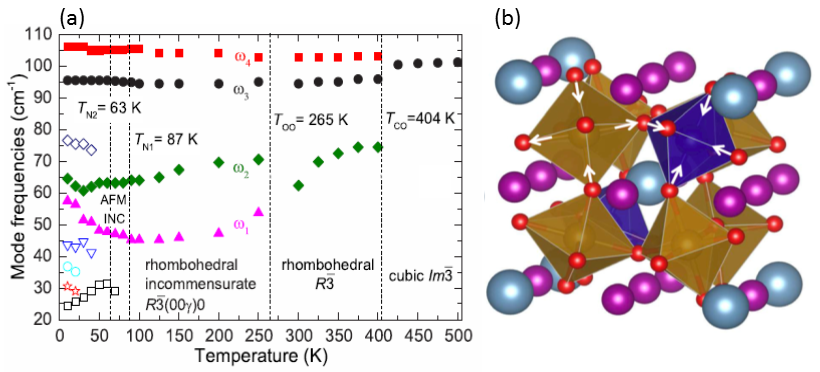
Figure: (a) Temperature dependence of the low-frequency excitations observed in THz and IR spectra of SrMn7O12. The open symbols correspond to spin excitations or phonons activated by breaking of the inversion center, whereas the remaining phonons are marked by solid symbols. (b) Rhombohedral quadruple perovskite crystal structure of SrMn7O12.
[1] S. Kamba, V. Goian, F. Kadlec, D. Nuzhnyy, C. Kadlec, J. Vít, F. Borodavka, I. S. Glazkova, A. A. Belik, Changes in spin and lattice dynamics induced by magnetic and structural phase transitions in multiferroic SrMn7O12, Phys. Rev. B 99, 184108 (2019).
(show less)
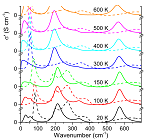
Soft mode driven local ferroelectric transition in lead-based relaxors
Analysis of IR and THz spectra using Bruggeman effective medium approach revealed that the mesoscopic structure of Pb(Mg1/3Nb2/3)O3 and Pb(Mg1/3Ta2/3)O3 consists of dynamic randomly oriented uniaxially anisotropic polar nanoregions with harder transverse optical polar modes in the direction along the local dipoles [1,2].
The lowest-frequency phonon of the E symmetry polarized perpendicular to the local dipole moments undergoes softening towards T* ≈ 400 K, which brings evidence about a local structural phase transition. This softening is also responsible for previously observed high temperature dependence of permittivity, which follows the Curie-Weiss law.
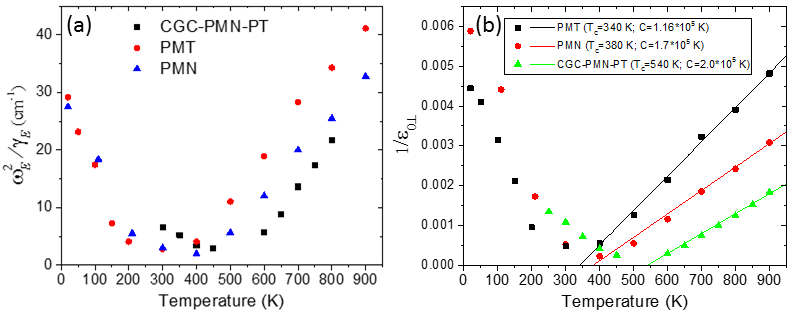
Figure: (a) Temperature dependence of the overdamped E component of the soft mode in PMN, PMT and PMN-PT characterized by frequency of the peak in dielectric loss. (b) Temperature dependence of the reciprocal static permittivity (perpendicular to local polarization in nanodomains) obtained from the fits of IR and THz spectra.
[1] D. Nuzhnyy, J. Petzelt, V. Bovtun, S. Kamba, J. Hlinka, Infrared, terahertz, and microwave spectroscopy of the soft and central modes in Pb(Mg1/3Nb2/3)O3, Phys. Rev. B 96, 174113 (2017).
[2] D. Nuzhnyy et al., Soft mode driven local ferroelectric transition in lead-based relaxors, Appl. Phys. Lett. 114, 182901 (2019).
(show less)
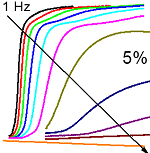
Wide Range Dielectric and Infrared Spectroscopy of (Nb+In) co-doped rutile ceramics
The dielectric response of ceramics of co-doped rutile Ti1-x(Nb0.5In0.5)xO2 has been measured via a combination of impedance, high-frequency coaxial, THz transmission, and IR reflectivity spectroscopies spanning 15 decades of frequency between 0.1 Hz and 240 THz [1]. It is argued that the colossal dielectric permittivity reported by other authors can be explained by a combination of thin low-conducting grain boundaries and low-conducting depletion near-electrode layers which give rise to thermally activated dielectric relaxations in higher radiofrequency and low-frequency ranges, respectively.
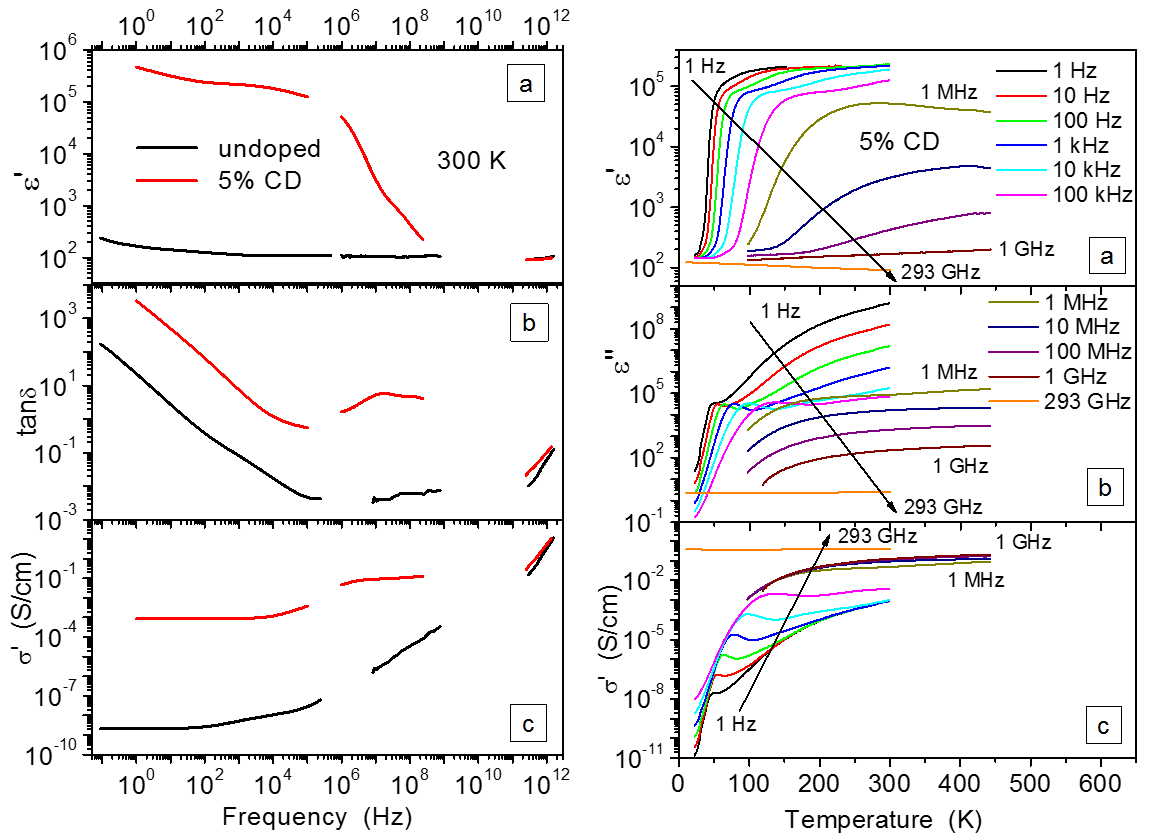
Figure: Left: Broadband spectra of the undoped and 5% co-doped rutile ceramics at 300 K. Right: Temperature dependences of the 5% (Nb+In) co-doped rutile ceramics at selected frequencies: (a) dielectric permittivity, (b) dielectric loss, (c) ac conductivity. Symbols denote the experimental data, lines correspond to the fits.
[1] V. Bovtun, J. Petzelt, M. Kempa, D. Nuzhnyy, M. Savinov, S. Kamba. S. M. M. Yee, D. A. Crandles, Wide range dielectric and infrared spectroscopy of (Nb+In) co-doped rutile ceramics, Phys. Rev. Mat. 2, 075002 (2018).
(show less)
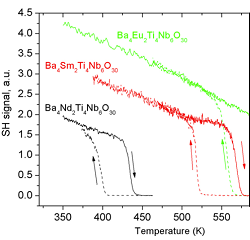
Electric-field-induced transition from incommensurately to commensurately modulated phase
Antiferroelectric-like polarization hysteresis loops in Ba4Sm2Ti4Nb6O30 and Ba4Eu2Ti4Nb6O30 were explained by electric-field induced structural phase transition from nonpolar incommensurately modulated structure to polar and commensurately modulated phase [1]. This discovery opens new perspective direction of investigation of lead-free materials for possible electric energy storage.

Fig. 1: Left – electron diffraction patterns in commensurately and incommensurately modulated phases in Ba4Sm2Ti4Nb6O30. Right – temperature dependence of second harmonic generation signal showing temperature hysteresis near ferroelectric phase transitions in investigated materials.
[1] Kun Li, Xiao Li Zhu, Xiao Qing Liu, Xiao Ma, Mao Sen Fu, Jan Kroupa, Stanislav Kamba, and Xiang Ming Chen, Electric-field induced phase transition and pinched P-E hysteresis loops in Pb-free ferroelectrics with tungsten bronze structure, NPG Asia Mat. 10, 71 (2018).
(show less)
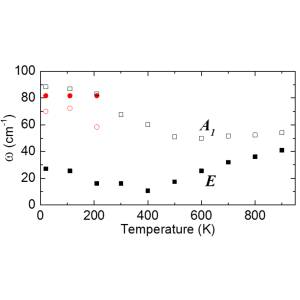
Infrared, terahertz and microwave spectroscopy of the soft and central modes in PMN
Analysis of IR and THz spectra using Bruggeman effective medium approach revealed that the mesoscopic structure of Pb(Mg1/3Nb2/3)O3 (PMN) consists of randomly oriented uniaxially anisotropic polar nanodomains with harder transverse optical polar modes in the direction along the local dipoles.
The lowest-frequency phonon of the E symmetry polarized perpendicular to the local dipole moments undergoes softening towards T* ≈ 400 K, which gives evidence about a local structural phase transition. This softening is also responsible for previously observed high temperature dependence of permittivity, which follows the Curie-Weiss law with the same critical temperature even without any anomaly in the low-frequency permittivity [D. Nuzhnyy et al, Phys. Rev. B 96, 174113 (2017)].
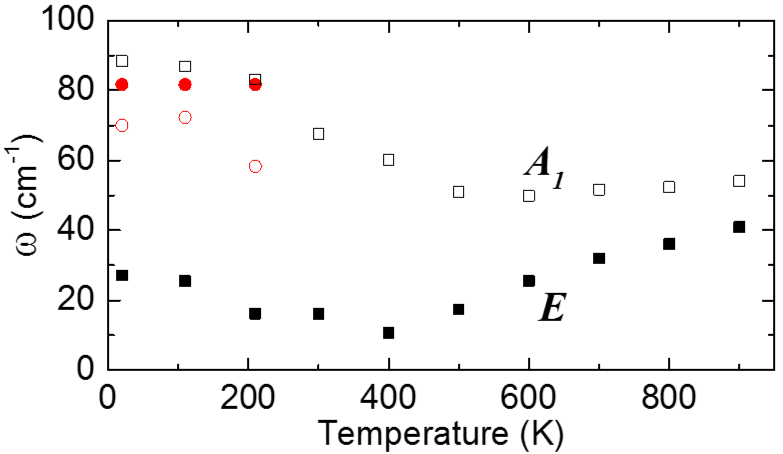
Figure: Temperature dependence of soft-mode components A1 and E in PMN from our terahertz and IR spectra.
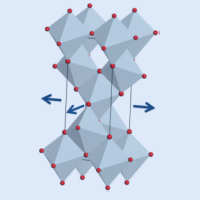
Can a tensile tensile strained TiO2 thin film be ferroelectric?
A series of papers about discovery of new ferroelectrics using PFM microscopy has recently been published. On the example of strained TiO2 thin films, which exhibit ferroelectric-like hysteresis loops, we have shown that PFM response can come from electrochemical effects like migration of defects.
Additional experiments like temperature dependent second harmonic generation, IR spectroscopy of phonons and X-ray diffraction are always necessary for unambiguous confirmation of ferroelectric phase transitions [ S. Skiadopoulou et al, Adv. Funct. Matt. 26, 642 (2016) ].
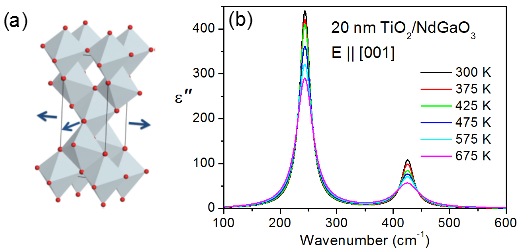
Figure: (a) Schema of anatase crystal structure of TiO2 under tensile strain. (b) Dielectric loss spectra calculated from temperature-dependent reflectance spectra of 20 nm thin film of TiO2 reveal no temperature shifts of phonon frequencies, because crystal structure is stable. PFM studies detected loss of “ferroelectric” polarization at 460 K.
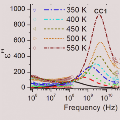
Broadband dielectric spectroscopy of lead-free relaxor ferroelectrics
Ba(Zr,Ti)O3 (BZT) and Na1/2Bi1/2TiO3 (NBT) have recently become recently the most studied lead-free relaxor materials for their attractive piezoelectric and interesting physical properties.
Our dielectric spectra of BZT of various compositions revealed that in addition to the lowest-frequency phonon mode near 1 THz, which is not much temperature dependent (no soft mode), there appear two relaxations in the spectra, the high-frequency one in the 1011 Hz range (assigned to quasi-Debye losses) and the dominant low-frequency one, which obeys the common Arrhenius law for all the relaxor compositions below ~ 200 K (see Fig. 1) [1,2] and accounts for the permittivity vs. temperature maxima characteristic for the relaxor behaviour. Since from first-principles calculations as well as structural characterization it follows that the local Ti-O and Zr-O distances in BZT are independent of composition, the characteristic polar nanoregions (PNRs) should be localised within the chemical nanoclusters of BaTiO3, where the Ti4+ ions are off-centred. Their simple Arrhenius thermal activation allowed us the assignment of the relaxations to local hopping of the Ti4+ ions among the off-centred positions within the Ti-O6 octahedra. This picture was also confirmed by analysing the relaxation and phonon dynamics using first-principles calculations for the BaZr1/2Ti1/2O3 composition in collaboration with the University of Arkansas, also separately for the Ti and Zr clusters [3]. This picture differs strikingly from the Vogel-Fulcher dynamics in lead-based relaxors, where there is no clear correlation between the PNRs and chemical clusters [4].
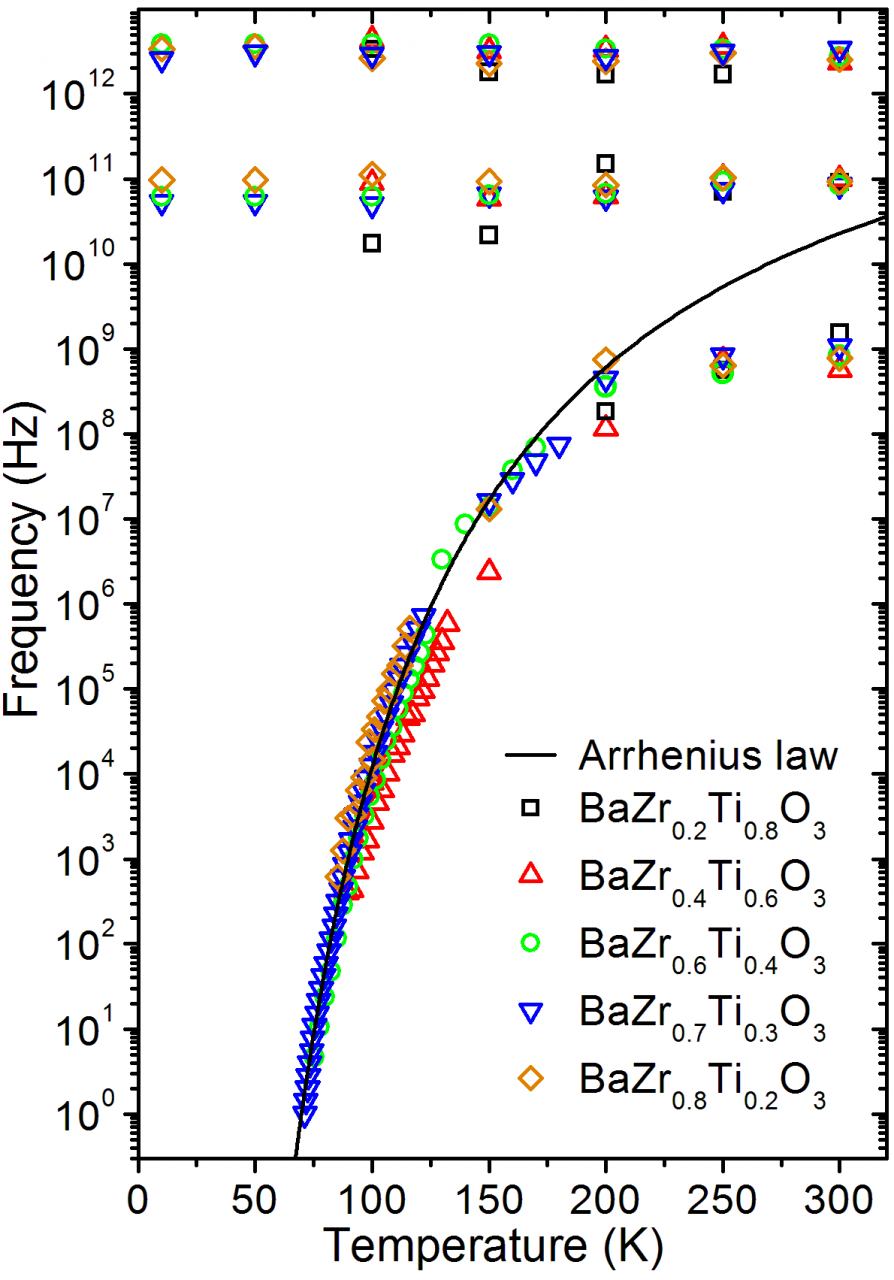
Figure 1: Temperature dependence of the characteristic frequencies of the main excitations in BZT at the THz and lower-frequency range. The low-frequency relaxation follows the same Arrhenius law for all the compositions and is assigned to local Ti ions hopping within the Ti-O6 octahedra in BaTiO3 clusters.
In collaboration with Institute Jozef Stefan in Ljubljana, Slovenia, the composition BaZr0.5Ti0.5O3 was particularly studied [5] and from the dielectric behaviour in external electric field it was concluded that the material lies on the crossover between a relaxor and dipolar glass.
In NBT the nature of the well-known dielectric anomaly near Tm ≈ 600 K was analysed for the first time [6], since its dielectric dispersion is not apparent below the standard MHz range. We have shown that the soft mode contributes only weakly to the permittivity, but it couples to two relaxations, from which the lower-frequency one is thermally activated and dominates the dielectric anomaly. At low temperatures only the soft mode contributes to the spectra. At higher temperatures it transfers part of its oscillator strength to both relaxations. Since Tm is specified by domination of the ferroelectric rhombohedral phase in the rhombohedral-tetragonal coexistence region, the permittivity maximum at Tm is caused by a smaller coupling of relaxation with the soft mode in the rhombohedral phase compared to that in the cubic and tetragonal phase. Some of the measured spectra and the analysed frequencies and dielectric strengths are shown in Fig. 2. The whole rather peculiar dynamics up to the soft mode in the THz range was assigned to highly anharmonic motion of the Bi3+ ions, which are known to be highly underbonded.
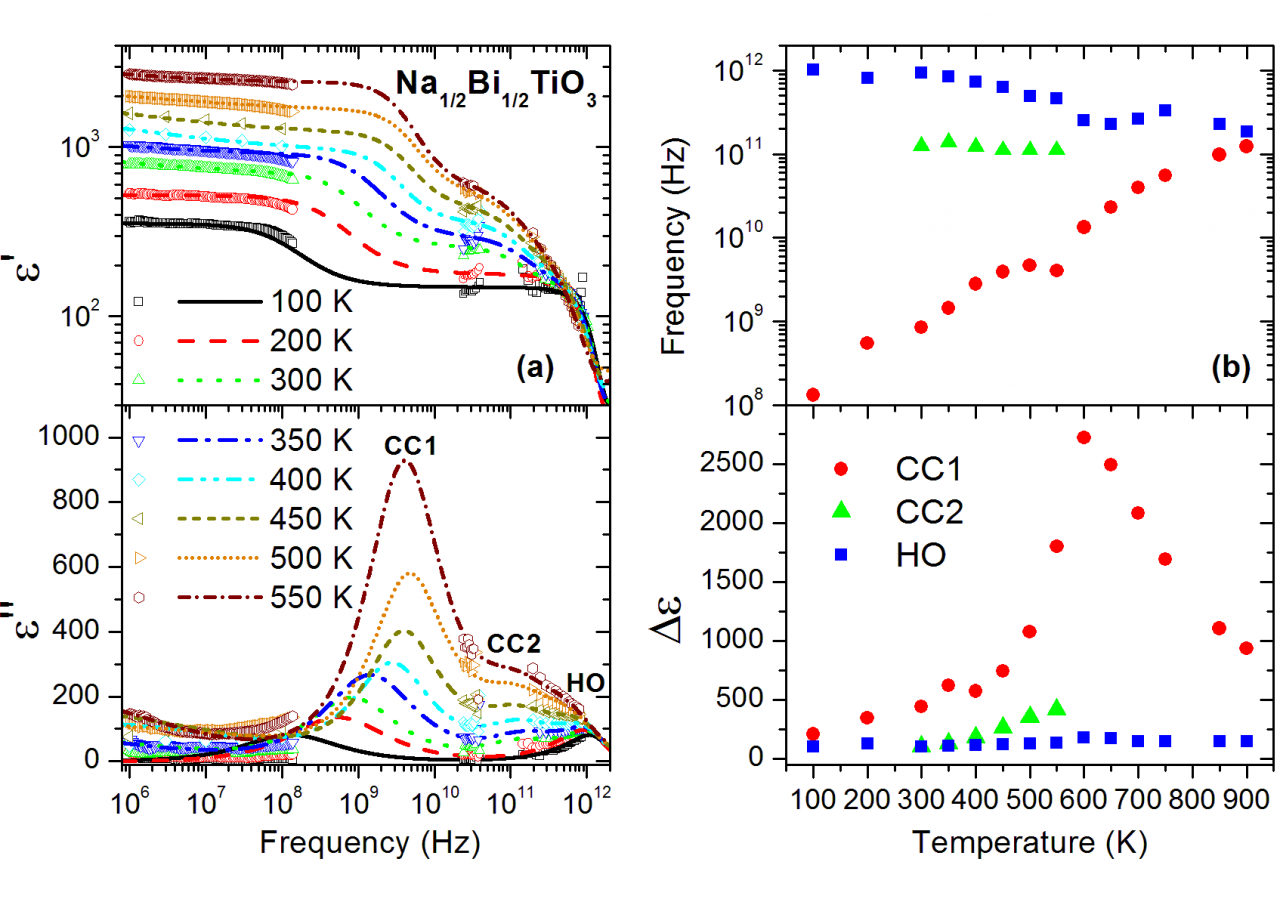
Figure 2: (a) Selected measured and fitted spectra in NBT. (b) Evaluated characteristic frequencies and dielectric strengths of the three modes below ~ 100 cm-1. Notice that the dominant relaxation is thermally activated and continues slowing down above as well as below the permittivity maximum near 600 K.
References
[1] D. Nuzhnyy et al., Phys. Rev. B 86, 014106 (2012).
[2] J. Petzelt et al., Ferroelectrics 469, 14 (2014).
[3] D. Wang et al., Nature Communications 5, 5100 (2014).
[4] J. Petzelt et al., Phase Transitions 88, 320 (2015).
[5] C. Filipic et al., Phys. Rev B 93, 224105 (2016).
[6] J. Petzelt et al., Phase Transitions 87, 953 (2014).
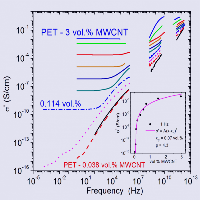
Ultra-broadband spectroscopy of dielectric-conductor nanocomposites
The ultra-broadband dielectric spectroscopy is particularly useful for studying dielectric–conductor nanocomposites, particularly near the electrical percolation threshold. Theoretically, we have studied the spectra of effective dielectric response of such composites using several models within the effective medium approximation. It was shown that the divergence of the static permittivity at the percolation threshold is caused by a strong dielectric relaxation, which softens on approaching the threshold with changing the composition, passing through the whole frequency range from infrared down to zero [1-3].
Experimentally, we have studied e.g. nanocomposites of polymers with carbon nanotubes (CNTs) [4]. A well electrically conducting CNT, due to its specific shape, enables processing composites with extremely low percolation threshold. Within our collaboration with Queen’s University in Belfast, who prepared well-dispersed composites of polyethylene terephthalate (PET) polymer with CNTs, we characterized them by broadband conductivity and dielectric spectroscopy, covering up to 17 orders of magnitude in frequency (10−4–1013 Hz) from room temperature down to 5 K. An extremely low percolation threshold of 0.07 vol% CNT was revealed as appearance of the low-frequency AC conductivity plateau corresponding to the DC conductivity, whose value increased with CNT concentration according to the power law with a high critical exponent of 4.3. Its semiconductor temperature dependence obeying the tunnelling law confirmed the model that each CNT in the percolating clusters is covered by a thin (~ 1 nm) layer of PET [4].
Our results on other nanocomposites of similar type were reviewed in [2,3]. Successful modelling of porosity in high-permittivity ceramics in infrared as well as low-frequency range using the Lichtenecker model was achieved for a classical relaxor PbMg1/3Nb2/3O3 (PMN) [3,5]. In collaboration with Brock University in Ontario, Canada, the giant permittivity in co-doped rutile TiO2 ceramics was explained as due to interfacial Schottky barrier layers between the electrodes and samples [6].
[1] J. Petzelt et al., Ferroelectrics 526, 171 (2012).
[2] J. Petzelt et al., Phys. Status Solidi A 210, 2259 (2013).
[3] J. Petzelt and D. Nuzhnyy, Phase Trans. 89, 651 (2016).
[4] D. Nuzhnyy et al., Nanotechnology 24, 055707 (2013).
[5] D. Nuzhnyy et al., Phys. Rev. B 89, 214307 (2014).
[6] D. A. Crandles et al., J. Appl. Phys. 119, 154105 (2016).
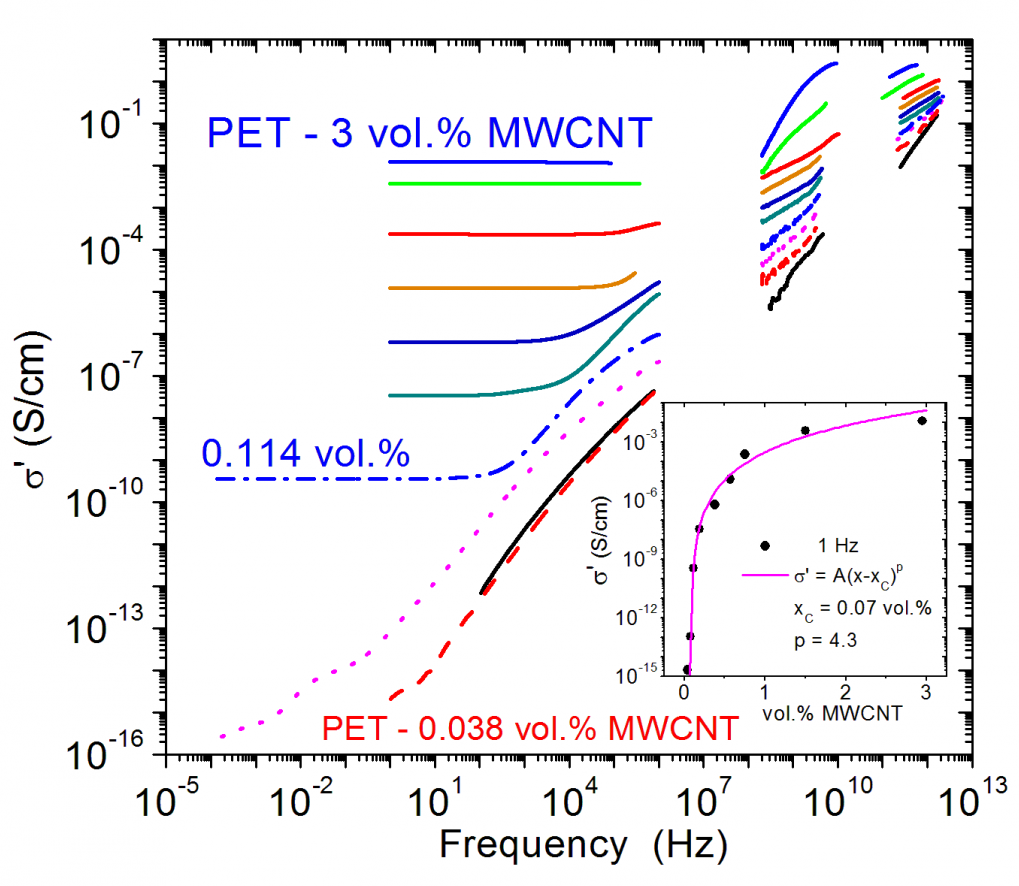
Figure: Room-temperature AC conductivity spectra dependent on the CNT concentration show that from the concentration 0.114 vol.% up, CNT plateaus of low-frequency conductivity appear, which correspond to DC conductivities and increase and broaden with the CNT concentration. The inset shows the critical power dependence of the conductivity at 1 Hz above the percolation threshold. At high frequencies the conductivity increases up to the THz range, which corresponds to the increase in localized conductivity due to the contributions from non-percolated CNT clusters.
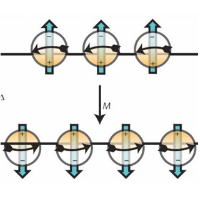
Magnetoelectric multiferroics
Magnetoelectric multiferroics are materials, which exhibit simultaneously magnetic and ferroelectric order. There is theoretically possible to influence magnetic or ferroelectric domains with electric or magnetic fields, respectively, therefore these materials are intensively studied for their promising potential applications in non-volatile memories. Unfortunately, there are only few multiferroics in nature and most of them work only at low temperatures. We suggested to use large mechanical strain in ultrathin films for preparation of new „artificial“ multiferroics.
We proved that originally antiferromagnetic and paraelectric EuTiO3 changes in films to strong ferromagnet and ferroelectrics due to strong spin-lattice coupling. Such system should exhibit strong magnetoelectric coupling which can be used in future memories. Paper was published in Nature [ J. H. Lee et al., Nature 466, 954 (2010)].
We also suggested using strong internal electric field in multiferroic Eu0.5Ba0.5TiO3 for the search of permanent electric dipole moment (EDM) of the electron. According to standard model of particles its value should be of order of 10–40 e.cm. Recently it has been shown that spontaneous violation of charge parity symmetry is much larger then it follows from the standard model, therefore this model needs an extension. New particle theories propose EDM of electrons 8 or 12 orders of magnitude larger then the standard model. The physicists try to measure EDM of electron already 40 years, unfortunately fruitlessly. They reached sensitivity of only 10–27 e.cm. We have shown that in multiferroic Eu0.5Ba0.5TiO3 the sensitivity should be one order of magnitude higher. We synthesized this material and prepared ceramic samples suitable for this measurement. In case of successful determination of EDM value it will be possible to prove and specify new theories going beyond the standard model. The paper was published in Nature Materials [ K. Z. Rushchanskii et al., Nature Mat. 9, 649 (2010)].

Figure: Scheme of the principle of measurement of an electric dipole moment of the electron. Electric and magnetic moments of the electrons switch with switching of the electric field which leads to a change of the measured magnetization.

